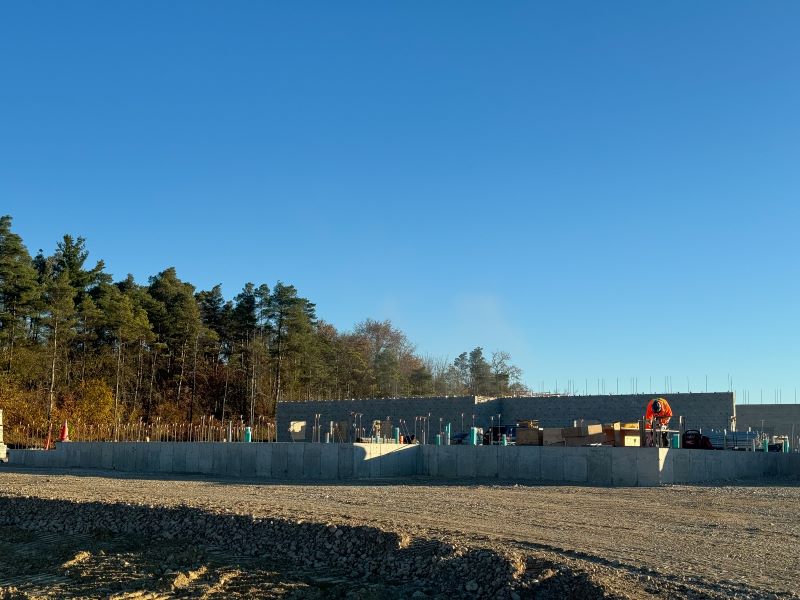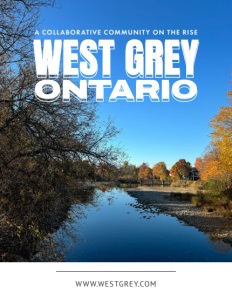A Collaborative Community on the Rise
Driving growth through a community-centric vision for sustainable success
Within the province of Ontario, West Grey stands out as a community where the promise of growth is balanced with thoughtful planning and sustainable practices. Located in Grey County, this municipality stands on the cusp of transformation.
Strategic developments executed by West Grey’s municipal leadership have made the roadmap for its success clear: embrace innovation, empower local partnerships, and ensure that progress reflects the community’s unique values and aspirations.
West Grey focuses on fostering economic development by leveraging partnerships with local businesses and developers. Collaborative, private sector ventures including the establishment of industrial parks allow the municipality to demonstrate its commitment to creating opportunities for residents while driving regional economic growth.
To facilitate this, West Grey’s leaders actively focus on streamlining provincial policies and regulations to reduce red tape and empower private enterprises to thrive, particularly in addressing housing challenges.
This ability to attract investment while maintaining affordability and sustainability has become a cornerstone of West Grey’s long-term prosperity.
West Grey’s infrastructure development is also vital to its growth strategy. Upgrades to roads, bridges, and utilities are not just necessities—they are the backbone of connectivity, accessibility, and community vitality.
Additionally, the municipality is modernizing basic services, such as water, sewer, high speed internet and natural gas, to support residential and commercial expansion and meet the needs of its growing population.
Overall, West Grey’s strategic sum will be a community that seamlessly blends economic opportunity with small-town values, where residents enjoy an enhanced quality of life, and visitors are drawn to its welcoming spirit.
West Grey’s future is shaped by ambition rooted in practicality, and the municipality stands as a shining example of how small municipalities can tackle significant challenges through forward-thinking leadership and community-driven initiatives.

A Community Navigating Residential Growth
Known for its vibrant rural landscapes and deeply rooted community ties, the municipality is navigating a period of transformation. This shift is driven by the need to balance housing demands, infrastructure modernization, and economic expansion.
“West Grey is a classic urban-rural mix. We have a couple of fully-serviced urban centers that are continuing to expand and develop. We’re getting more and more connectivity,” says Mayor Kevin Eccles, commenting on the new high-speed fibre-optic internet connections that were recently installed throughout the more rural areas of the municipality.
West Grey residents also have an abundance of outdoor recreational activities, and the municipality and its partners continue to invest in these assets to enhance quality of life.
The Saugeen Valley Conservation Authority owns approximately 2,500 acres of property that is accessible to the public, and the municipality works closely with the Conservation Authority to support and complement programming along the watershed.
Recently, West Grey has seen growth within the agricultural community, including new Mennonite and Amish farm operations, that enhance and complement the long agricultural heritage of the area, while embracing new opportunities and technology that drive farming innovation.
“We’re seeing that home building has really taken off in both urban centers and rural areas as well.” Mayor Eccles confirms.
Housing affordability and availability are issues that resonate across North America. West Grey is no exception, but Mayor Eccles and his council recognize the importance of addressing these concerns from a long-term perspective.
Despite the available land, West Grey is somewhat limited due to funding and has, as such, turned to the private sector to lead the charge.
The mayor emphasized that while municipalities are not in the business of building houses, their role is to create an environment where private developers can thrive. One critical approach involves cutting through bureaucratic red tape.
The current provincial policy framework often slows down development, requiring builders to navigate complex regulations. Streamlining these processes can empower private enterprises to address housing shortages more effectively.
“If we want to encourage affordable housing, then we’ve got to change our old legislation and regulations and embrace private enterprise. We’ve got to step out of their way… private enterprise is willing. Still, they don’t want to have to go through the hassle of satisfying 75 different agencies to be granted building permits,” Mayor Eccles explains, referencing how local developers are stepping up to contribute to affordable housing solutions.
West Grey is fortunate to have a good inventory of rental properties, which helps retain young people in the community. However, pressures on rent have increased due to urban out-migration from the city during COVID-19.
So, the local and private developers committed to projects that prioritize community value over profit have been invaluable, and the municipality does everything it can to make developments as affordable as possible.
Balancing affordability with long-term viability also involves tough conversations about development charges. Waiving development fees may benefit developers but often shifts the financial burden to local taxpayers. This delicate balance highlights the need for collective dialogue with provincial and federal governments.
Business and Infrastructure as the Cornerstone of Community
Economic development in West Grey is deeply intertwined with community values and local partnerships.
The municipality’s collaboration with longstanding businesses such as Domm Construction underscores this approach. Domm Construction, a family-run business with over 50 years of experience, is known for projects like the new West Grey police station and ambulance bay that are currently under construction.
Similarly, Candue Homes, founded by a local entrepreneur with decades of experience in larger markets like Orangeville and Guelph, has been instrumental in residential development with a community-first approach.
The company’s return to West Grey has sparked significant residential development while maintaining a focus on sustainability and community engagement.
On the commercial side, another exciting development is Chapman’s Ice Cream’s expansion. Known globally for its high-quality products, Chapman’s expansion will bring economic opportunities not just to West Grey but to the entire Grey County region.
Fortunately, West Grey is blessed with many private-sector developers who can supply both its commercial and housing demand, so naturally, the municipality’s leadership has positioned itself as a primary supporter.
“We want to be the concierge and facilitate opportunities for our business community,” says Chief Administrative Officer Michele Harris, The Municipality’s Community Improvement Plan (CIP) is one such tool to encourage private sector investment.
“Annually, the Municipality invests $100,000 in the CIP program to encourage private sector investment in our commercial and industrial sector” Harris explains.
West Grey’s Community Improvement Plan offers incentives for new businesses to locate there, supporting them in many ways, such as covering planning fees, signage, and the like.
Under Ontario’s Municipal Act, West Grey faces some restrictions on how it can support new businesses. However, its Community Improvement Plan gives it tools to use to attract new businesses and support business retention.
As a result, West Grey’s growth strategy heavily embraces private-sector development, but that still leaves the challenges of helping these businesses navigate the regulatory “red tape” and providing the infrastructure needed for sustainable growth.
West Grey boasts ample land and the potential to provide necessary infrastructure, such as water and sewer systems. However, funding remains a hurdle. The municipality’s leadership has also been vocal about the importance of upgrading roads, bridges, and utilities to support both residents and businesses.
The new Rockwood Terrace, a 128-bed long-term care facility, stands as a testament to this commitment, and showcases intergovernmental collaboration for community benefit Similarly, natural gas installation in Neustadt and fibre optic upgrades are expected to benefit the local community significantly.
“Infrastructure upgrades are paramount,” the Mayor Eccles explains. “We need to ensure that people and products can move efficiently through West Grey. Whether it’s for agricultural goods or tourism, connectivity is key.”
Beyond transportation, West Grey is also focused on facilitating industrial growth. A new 33,000-square-foot industrial park is underway, and plans are in place for a potential Phase 3 expansion.

A Vision for the Foreseeable Future
While local initiatives drive much of West Grey’s progress, provincial and federal policies will always play a critical role in shaping the municipality’s trajectory.
Mayor Eccles has called for more streamlined processes to enable private enterprises to take the lead.
“Conversations with organizations like AMO (Association of Municipalities of Ontario), ROMA (Rural Ontario Municipal Association), and FCM (Federation of Canadian Municipalities) are crucial. These groups amplify our voice and bring our challenges to the attention of higher levels of government,” Harris states.
Looking ahead, West Grey’s leadership has outlined several priorities for the near term.
In addition to completing Rockwood Terrace, the new West Grey Police Station and advancing industrial park projects, the municipality aims to support natural gas infrastructure upgrades in Neustadt, facilitate Chapman’s Ice Cream’s expansion, advocate for policy reforms to streamline development processes, and continue upgrading roads, bridges, and utilities to enhance connectivity.
These initiatives reflect a balanced approach to growth, emphasizing both immediate needs and long-term sustainability.
“It’s about creating a community that people are proud to call home,” Mayor Eccles says. “From housing to infrastructure, every decision we make is guided by the goal of enhancing quality of life for our residents.”
Harris echoes this sentiment, emphasizing the importance of collaboration. “Whether it’s working with local developers or engaging with provincial and federal governments, our focus remains on building a vibrant, resilient community.”
As West Grey moves forward, its blend of small-town charm and ambitious vision positions it as a model for rural municipalities across Canada.
At a Glance
Who: West Grey, Ontario
What: A rural municipality in Grey County, Canada, poised for growth through innovative development, community partnerships, and sustainable practices.
Where: Located in the heart of Grey County, Ontario.



